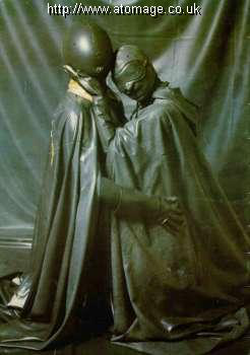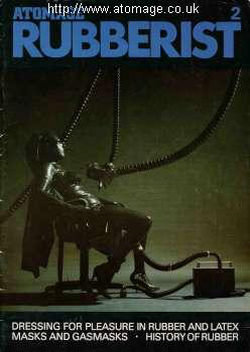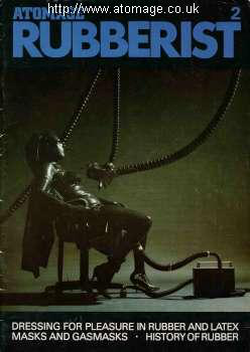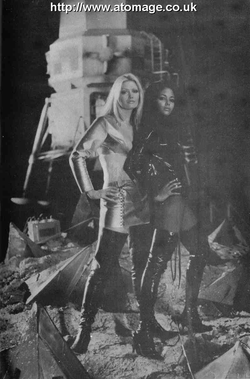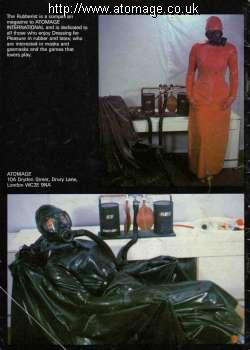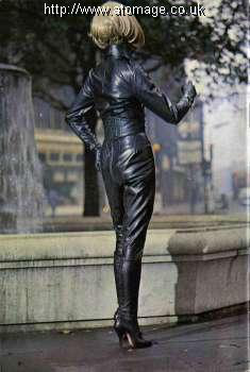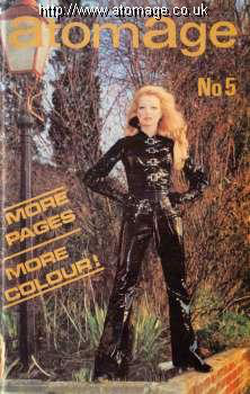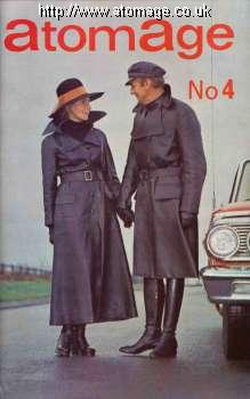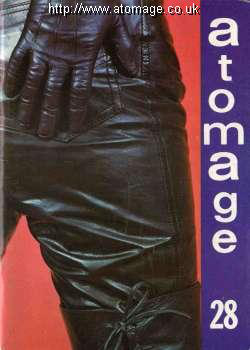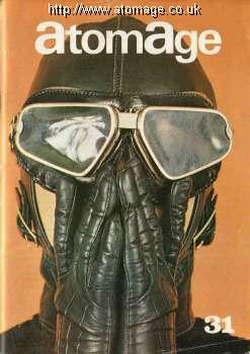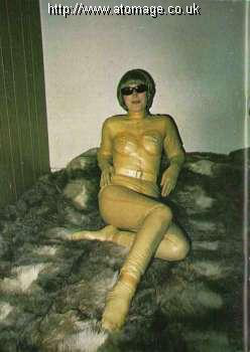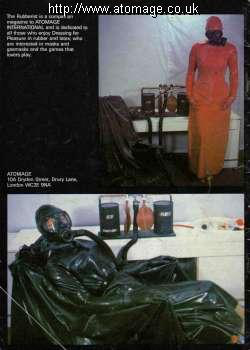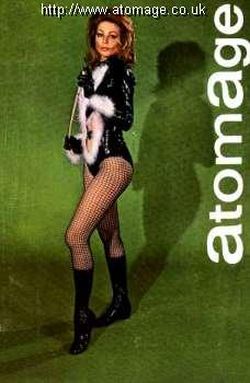Atomage Magazine and Leather Couture

Atomage Magazine and Leather Couture
Atomage Leather Couture was a company run by John Sutcliffe from the 1950's to the late 1980's.
History
John Sutcliffe, founder of Atomage Magazine and Couture, graduated from the College of Aeronautical Engineering in Chelsea he later became chief inspector of engines with the pre-war British Airways, he also designed a cigarette packet sized wireless receiver and enjoyed repairing antique china.
However throughout his life he had a special attachment for leather, it was something he tried hard to suppress, sadly this led to a breakdown and the collapse of his nineteen year long marriage.
After trying unsuccessfully to get a job as an aircraft engineer he looked for alternative ways of earning a living including driving a mini-cab and taking wedding photographs (although surprisingly very few pictures of John exist as he preferred to be behind the camera rather than in front of it).
As his life came back together John purchased a motor bike and one evening took a lady friend out, unfortunately it was raining and she got rather wet, John soon discovered that leather motorcycle clothing for small ladies was very hard to find so the ever resourceful John decided to make an outfit for her, when her friends saw what John had created they all wanted one just the same.
In 1957 John Sutcliffe started Atomage as "a manufacturer of weatherproofs for lady pillion riders" the business was located in a back room in Hampstead and had a secondhand sewing machine that John adapted himself to cope with leather and vinyl, he taught himself dressmaking.
After ten years the business had moved to 10a Dryden Street off Drury Lane, London, previously the premises had been a hay loft for livery stables.
By 1967 John had experimented with the then new materials of PVC and rubber, he invented a new method of bonding rubber, creating a new glue and modifying a travel iron to seal the seams, this lead to him producing his first rubber garment.
Atomage Leather and Latex
T he quality, cut, fit and style of the Atomage motorcycle leathers were far superior to anything available in the shops, John's designs soon got noticed and he was asked to produce leather and vinyl outfits for the stage and screen, some of his most famous creations can be seen in The Avengers TV series, although John did not design the Avengers costumes but they were made by him in the Atomage workshops.
In 1967 the Granville Chemical company (makers of protective polish and anti-freeze for cars) were looking for something to attract customers to their stand at the Motor Show, so they hired a female model and commissioned John Sutcliffe to create a special outfit (with the emphasis on protection), the advertising slogan which went with the lady wearing the suit was "*She has leather protection.
Has your car the protection of our chemical products?*", the outfit was an instant success with photographs appearing in newspapers such as the Daily Mail.
One of John's most famous designs was a one piece cat suit complete with high heeled boots, this outfit John called the Atomage Bootsuit, Atomage regularly produced one off and specially commissioned outfits, including leather outfits for female customers who "wore them for professional reasons.....".
John soon found that a quarter of the garments produced in the Atomage workshops never went out in public, the outfits were worn in private just for pleasure, having experienced the failure of his own marriage because of his leather fetish he was aware of the problems that can occur when a female is asked to dress in leather by her partner.
John understood that a female is someone to be loved and cared for and that males have a primal attraction to leather, all the male want to do is wrap the person he loves to protect her.
In the winter of 1972 John started Atomage magazine at the suggestion of Helen Henley who was a regular customer of Atomage, John hoped to use the magazine as not only a showcase for his new designs but as a means of explaining to females the reasons why males want to see them dress in leather clothes.
Helen Henley was given a regular column in the new magazine, the magazine also featured the "Atomage Correspondence System" (ACS) where readers could contact each other, the readers were actively encouraged to provide pictures and stories for inclusion in the magazine.
T he Atomage magazine proved extremely popular, it was A5 in size priced at £2 per copy and was only available by private subscription directly from Atomage, initially the magazine only featured outfits in leather but gradually rubber garments became more prominent, slowly bondage started to be featured in the magazine, this lead to displeasure from some readers so in 1976 edition 13 came with a special supplement, this supplement was a separate magazine that contained only the bondage, the main magazine then returned to concentrating on the normal Atomage fetish clothing, a reader could opt to receive the bondage supplement which was not available for sale separately from the main magazine.
Atomage magazine concentrated on the most modern leather and rubber fashion of the day including reports from the various fashion shows that took place during the year, it was a true enthusiast magazine, it was run by enthusiasts for enthusiasts, you had the feeling that John really enjoyed what he was doing and that profit came second.
John also turned his hand to film production, his most memorable work is a short film entitled "Under Three Layers".
In 1980 after 32 A5 sized issues of Atomage and 20 issues of the bondage supplement John decided to review the strategy of the business, the magazine did not have a large circulation but there was growth potential being at the forefront of what today we call the "fetish" scene so John decided build on his reputation and success so he restructured the magazines.
"Atomage International" was launched (to succeed the A5 Atomage magazine and concentrate on the leather clothing), he renamed the bondage supplement "Atomage Bondage" and launched a new magazine "Atomage Rubberist" which catered for the rubber fetish scene.
International distributors were found for the three magazines, they were to be truly world-wide publications.
Atomage also sold books and other publications dedicated to the fetish/bondage scene, unfortunately a member of the public referred a copy of the book "The Story Of Gerda" to the police and in November 1983 the Atomage premises were raided and all the published material on the premises was seized, to make matters worse the printers of Atomage were also raided and the printing plates for the Atomage magazines were seized.
Downfall of Atomage and Death of John Sutcliffe
John was informed that he would not be prosecuted for publication of the Atomage magazines if he allowed his entire back stock of magazines and printing plates (valued at £50,000) to be destroyed, unfortunately he was not so lucky with the Gerda books, for these publications he was fined £1000.
In December 1983 Atomage moved to Unit 3A, 98 Victoria Road, Park Royal, London, NW10.
The prosecution and loss of stock created serious financial problems for John and Atomage.
The level of public outrage at Johns prosecution was such that he started receiving cheques and money in the post from customers of Atomage to help him keep the business running.
The destruction of every unsold copy of the Atomage magazines was bad enough but the loss of the printing plates created serious problems for John as he could not re-create the magazines again, customers who had copies of the magazines sent them back to John so he could sell them again.
The police raid did not stop John producing magazines, indeed several editions of Atomage International, Atomage Rubberist and Atomage Bondage were subsequently produced.
Sadly John died in his office one Sunday afternoon in September 1987 whilst working at his desk, one of his intentions was to bring in to the open the idea that people have fetishes, today he is considered one of the patron saints of the world wide rubberist community.
Due to the small production runs (only 800 copies of edition 1 of the A5 magazine were ever produced) and the destruction of most of the stock by the police, the Atomage magazines are now extremely rare and highly sought after by collectors.
After Johns untimely death the Rubberist magazine title was purchased by G&M Fashions who continue to print new editions.

